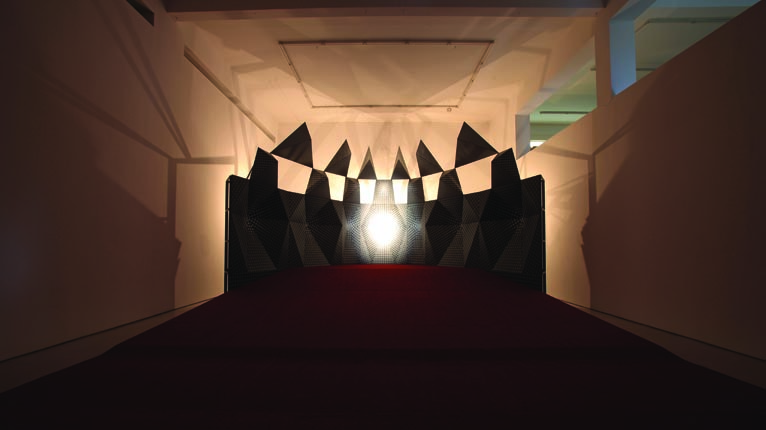LI SHURUI
| July 31, 2012 | Post In LEAP 15

Within the dim lighting of this exhibition space towers a six-meter-high “construction matrix,” stretching nearly to the ceiling. This semi-circular, domed form is both church- and cave-like, composed of polyhedral forms joined at three separate levels and adorned with Li Shurui’s now trademark black, white, and gray “dot paintings” of varying sizes. These paintings, 106 in all, thus form the keynote to this deep-gray, towering installation of paintings.
Following the sloping red carpet, the audience gradually enters the immersive atmosphere of this piece, which one could also call a custom built “art room.” Once inside, the audience can observe the paintings on the walls up-close, though, due to a lack of lighting within the enclosed area, the majority of the paintings’ bright white dots glimmer faintly. This dimness is contrasted by a strong refracted glare coming from an intensity of white dots at the center of the piece. The source of this glare is a spotlight, deliberately installed by the artist directly opposite the installation, which shoots straight into the audience’s line of vision as they turn to leave, the effect of which, in conjunction with the redness of the carpet underfoot produces the same illusion of dazzling blindness as on-stage “limelight.” This glare both acts as a necessary light source and constructs an unusual atmosphere, while simultaneously forming a kind of reciprocal relationship with the lights, the central theme of the paintings. But on this occasion, the paintings have been reduced to an element within the larger “art room,” making the architecture of the construction and the actual light source both important components in the same sense. The bright dots of former paintings, diffused and glittered like clusters of particles, have here been subordinated and integrated into a total atmosphere of ceremony.

Over the past seven years, Li Shurui has primarily focused on the painting of particles, polychromatic faculae of light onto flat surfaces, exploring the ways in which pure visual experience can be brought to an audience. But on this occasion, her first solo exhibition in Beijing, Li chose not to show her representative works, but instead astutely combined her years of experience of painting with an indulgent, ambitious, and almost puritanical approach to installation art and spatial design. A similar attempt was made by Li at the Today Art Museum in 2011, with her spotlight “curtain wall.” She is clearly not content with the confines of two-dimensional painting, and is trying to find ways to make the experience of viewing a painting more unfamiliar and immersive, thus bringing about a completely new visual and psychological experience.
But returning to a critique of Li Shurui’s current practice: we ought not to merely limit our interpretation to the ways in which this young artist may differ from a previous generation of Chinese contemporary artists and their ideologies or modes of producing social narrative. We should instead be more bold, and place its signifiers within a historical global perspective, alongside the artist’s personal enlightenment and development. For Li, who initially adopted intuitive physiological experience as a creative pathway, has long ago shaken off the burdens of ideology and social narrative. Thus, the metaphysical exploration of light and spatial expression conditioned by rational thought and control, the primary pursuit of experience, and the challenge of taking this experience to its greatest height— all of these elements now form a powerful response to the challenge presented by the ornamental possibilities in her work. These possibilities, these future “unknown shimmers,” certainly deserve our continued attention. Chang Xuyang (Translated by Dominik Salter Dvorak)

